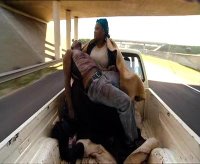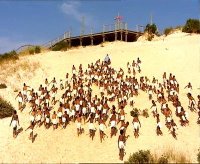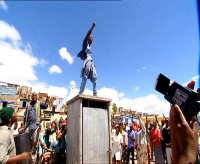Jezile (Son of Man) Scene Guide
 Having reviewed Mark Dornford-May's Son of Man a fortnight ago, I now want to examine the passages from the bible it utilises. This is slightly more complicated than usual as the modernisation necessarily distorts some of the passages. It's also difficult because the imaginative treatment of Jesus's death is a more symbolic treatment of the events than a literal modernisation, but more of that below.
Having reviewed Mark Dornford-May's Son of Man a fortnight ago, I now want to examine the passages from the bible it utilises. This is slightly more complicated than usual as the modernisation necessarily distorts some of the passages. It's also difficult because the imaginative treatment of Jesus's death is a more symbolic treatment of the events than a literal modernisation, but more of that below.Temptation - (Matt 4:1-11)Notes
[extra-biblical episodes]
Annunciation - (Luke 1:26-38)
Magnificat - (Luke 1:46-55)
Birth of Jesus - (Luke 2:1-7)
Shepherds and Angels - (Luke 2:8-20)
Wise Men - (Matt 2:1,11)
Joseph Warned - (Matt 2:13-5)
Slaughter of the Infants - (Matt 2:16)
Baptism - (Mark 1:9-11)
Calling the 12 - (Mark 3:13-19)
Death of Herod - (Matt 2:19)
[Various Teaching]
[extra-biblical episode - amnesty]
Adulteress - (John 8:2-11)
Jesus Anointed by a Woman - (John 12:1-8)
Judas' Agrees to Betray - (Mark 14:1-10)
[Various Teaching]
Jesus Predicts his Death - (Mark 8:31)
Healing of a Paralytic - (Mark 2:1-12)
[Various Teaching]
Raising of Lazarus - (John 11:1-44)
Exorcism of Young (Wo)man - (Mark 9:14-29)
"Sermon on the Mount"
[extra-biblical episode]
Jesus and the children - (Mark 10:13-16)
Triumphal Entry - (Mark 11:1-10)
Conflict with the Elders - (John
[extra-biblical episode]
Pilate and the Elders - (John 18:28-31)
Last Supper - (Mark 14:17-25)
Jesus Predicts Peter's Denial - (Mark 14:26-31)
Gethsemane - (Mark 14:32-42)
Arrest of Jesus - (Mark 14:43-50)
Beating and Mocking - (Mark 14:65)
Peter's Denial - (Mark 14:66-72)
Burial of Jesus
Death of Jesus
"Resurrection"
Crucifixion
Ascension
 The following paragraph contains spoilers. As referred to above, the most inventive re-interpretation in the film is the events of Jesus's final week. In order to create a credible scenario, and to fashion the most compelling message for it's audience, Dornford-May moulds the arrest and death of Jesus into that of modern, African, minority-resistance leaders. So the narrative departs from the biblical order of events as early as the Triumphal Entry. Immediately afterwards Jesus meets with Caiaphas and Annas ("The Elders") in the parallel of the Sanhedrin (or not) trial scenes. Pilate then meets with the elders and agrees to turn a blind eye to their actions regarding Jesus - washing his hands in the process. The film then moves to the Last Supper and Gethsemane and Jesus's arrest. However, when Jesus is mocked and beaten, he is beaten into a coma, and then placed in the grave, and then shot. It is left unclear as to whether Jesus dies from the beating or from the shooting.
The following paragraph contains spoilers. As referred to above, the most inventive re-interpretation in the film is the events of Jesus's final week. In order to create a credible scenario, and to fashion the most compelling message for it's audience, Dornford-May moulds the arrest and death of Jesus into that of modern, African, minority-resistance leaders. So the narrative departs from the biblical order of events as early as the Triumphal Entry. Immediately afterwards Jesus meets with Caiaphas and Annas ("The Elders") in the parallel of the Sanhedrin (or not) trial scenes. Pilate then meets with the elders and agrees to turn a blind eye to their actions regarding Jesus - washing his hands in the process. The film then moves to the Last Supper and Gethsemane and Jesus's arrest. However, when Jesus is mocked and beaten, he is beaten into a coma, and then placed in the grave, and then shot. It is left unclear as to whether Jesus dies from the beating or from the shooting.  However, then his mother Mary learns of the location of Jesus's body and releases him from the grave (a "resurrection" of sorts). Mary then displays his body on a cross - the significance of which is discussed in my review. Finally, we see Jesus climbing a hill with a host of the feathered angel boys - a scene of ascension. The result is a iconic yet modernised depiction of the events of Christ's death which relies on visual and thematic similarities for its points of comparison rather than strict adherence to the original narratives.
However, then his mother Mary learns of the location of Jesus's body and releases him from the grave (a "resurrection" of sorts). Mary then displays his body on a cross - the significance of which is discussed in my review. Finally, we see Jesus climbing a hill with a host of the feathered angel boys - a scene of ascension. The result is a iconic yet modernised depiction of the events of Christ's death which relies on visual and thematic similarities for its points of comparison rather than strict adherence to the original narratives.The issue of laying down arms is key to this film. The common episode from John 8 where a mob is dissuaded from executing an adulteress is not only included here, but also preceded by a scene where Jesus gets the twelve to surrender their guns. Both scenes how weapons of one form or another being laid down. Later when the Sermon on the Mount is disbanded by government soldiers Peter considers throwing a rock, only for Jesus to order him not to, prefiguring the arrest in the garden. This ties in with the film's overall theme of non-violence and a call to a peaceful resistance movement. Matthew, for example, is not a tax collector called to surrender his ill gotten wealth, but a resistance fighter who has to lay down his arms to follow Jesus.
 I want to revisit the various blocks of teaching in a later post, as in most cases it has been radically revised. Essentially, each section of teaching pieces together a number of disparate phrases from the gospels, and then updates them so they form coherent sermons to the modern world he inhabits. That said one speech is delivered to a crowd from the top of an iron shack - a subtle reference to the Sermon on the Mount.
I want to revisit the various blocks of teaching in a later post, as in most cases it has been radically revised. Essentially, each section of teaching pieces together a number of disparate phrases from the gospels, and then updates them so they form coherent sermons to the modern world he inhabits. That said one speech is delivered to a crowd from the top of an iron shack - a subtle reference to the Sermon on the Mount.Labels: African Bible Films, Jezile (Son of Man 2006), Modernisations, Scene Guides














1 Comments:
At 11:59 am, August 23, 2006, D H Friesen said…
D H Friesen said…
Hey, Matt. Where did you get a copy of this? Is it out on DVD now?
df
Post a Comment
<< Home